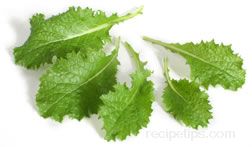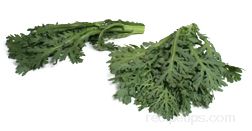|
Greens Preparation | Greens Cooking | Tips
| Greens |
|
 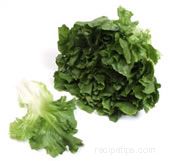 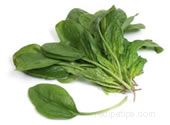
A generic name given to several types of leafy vegetables such as spinach, mustard greens, escarole, dandelion, and turnip greens that are often used in salads. Each type has a unique flavor and can be eaten alone or mixed with other types for a blend of flavors. The different tastes and textures of various greens adds diversity to a salad. They have a higher nutritional content than lettuce and most often the darker the leaves are, the higher the nutritional content. Also referred to as "salad greens". |
|
Uses:
The various types of salad greens can be eaten alone or mixed together to create a blend of flavors. They are added to lettuce salads and other salads to add color, enhance the flavor and add nutritional value. Some can be cooked by stir-frying or sautéing and then served as a side dish or they can be added to pasta and vegetable dishes. They can be added to soups at the end of the cooking time or used on sandwiches in place of lettuce. |
|
At Their Best:
There is generally a nice variety of greens readily available throughout the year because they are grown in so many different areas of the world. Their seasons peak at different times of year, depending on the area. |
|
How to Buy:
Look for greens that are crisp and fresh. Avoid any that have wilted leaves, discolored edges, blemishes, or slimy spots. They should have a sweet, fresh smell. If they have a sour smell, do not purchase. Head type greens should be firm and free of blemishes or damaged areas. |
|
Storage:
When the greens are first brought home, any rubber banding or ties should be removed to avoid damage. The damaged, discolored or wilted greens should be thrown away. The greens can be stored washed or unwashed, but they must be dried properly before storing. See Greens Preparation below for techniques on washing and drying greens. Once the greens have been dried properly, wrap small batches in dry paper towels and place in a resealable plastic bag. Do not overpack the greens so they will have room to spread out. Then gently press the air out of the bag and seal it. The paper towel will help to absorb moisture that may still be on the greens. Exposure to excess moisture and air will cause the greens to deteriorate quicker. After the air is removed and the bag is sealed, place it in the refrigerator crisper. The greens can be stored anywhere from 3 days to a week, depending on the type of green. Some of the delicate greens, such as mache, can only be stored for a day or two. It is best to buy the more delicate greens just before you are going to use them to ensure freshness. Greens sold with the roots still attached should be searched for insects and then the roots should be wrapped in damp paper towel. Place the bunch with wrapped roots in to a plastic bag or place the wrapped roots in a glass and cover with a plastic bag. Do not store greens next to ethylene gas producing fruits, such as apples and bananas. The ethylene gas they produce will cause premature ripening and the leaves will become spotted and they will begin to decay. It is best to store all greens for the shortest time possible to ensure freshness. |
| Varieties: |
|
Arugula
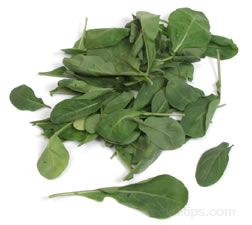 |
A Mediterranean plant, with dark green, multiple-lobed leaves, belonging to the mustard family and commonly used as a salad green. It has a hot, peppery, sharp taste and is a very popular ingredient for Italian dishes. The seeds of the plant are used for flavoring oils. Arugula is also known as arrugula, rugola rugula, rocket, Italian cress, roquette, and rucola. |
|
Belgian Endive
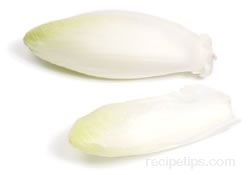
|
Belgian endive has narrow, spear-shaped leaves that are creamy white with very pale yellow tips. Grown in the dark to prevent the leaves from turning green, this plant is a member of the chicory family. It has a mild taste and is more expensive than curly endive, which is the other common variety of endive. Belgian endive is also known as Belgian chicory, Brussels chicory, blanching chicory, chicon, Dutch chicory, French endive, witloof (Flemish for white leaf), or witloof chicory. (The confusion occurs due to the fact that the term "chicory" in America or France refers to what Britain calls endive.) |
Collard Greens
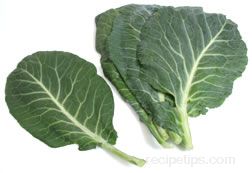 |
A type of leafy green plant related to kale that is used in salads and cooked as a vegetable. Collard Greens have the best flavor when they are sautéed. They are very popular in southern areas of the United States. |
|
Curly Endive
 |
A variety of endive that is a member of the chicory family of greens. It grows prickly green leaves that provide a slightly bitter taste. It is commonly served as a salad green. Curly endive is often referred to as chicory and may confuse many when labeled as loose-leaf endive or some of its other names such as loose-leaf chicory, chicory, chicory endive, curly chicory, frisée, or frise. The confusion occurs due to the fact that the term "chicory" in America or France refers to what Britain calls endive. |
Dandelion Greens
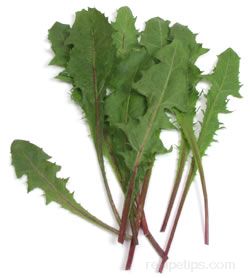 |
Refers to the leaves of the Dandelion plant, which are considered a weed in the United States, but are actually one of the most vitamin rich foods available. Mature leaves have a very bitter taste, but younger leaves are milder. They are an excellent salad ingredient and are often cooked as a side dish. The leaves should be washed thoroughly and dried before using. |
Escarole
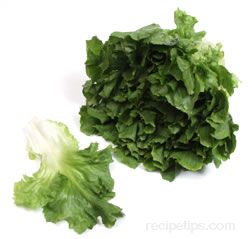 |
A crisp, broadleaf type of endive most often served as a salad green that is also known as escarole, broad chicory, or common chicory. This member of the chicory family has broad outer leaves with a crinkled shape. The leaves provide a slightly bitter taste, yet not as bitter as Belgian or curly endive. As the outer leaves are removed, the inner leaves display a paler green coloring with more white and a taste less bitter than the outer leaves. Escarole is popular as a salad green, eaten raw with mayonnaise or a vinaigrette dressing. |
|
Mache
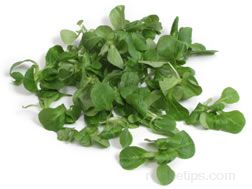 |
A salad green that has small dark green, velvety leaves with a rich, sweet flavor, similar to hazelnut. In addition to salads, this green can also be steamed and served as a vegetable. Mâche is grown in France, Holland and the United States and is also known as Corn Salad, Field Salad, Field Lettuce, Lamb's Lettuce, or Lamb's Tongue. It is often found growing wild in fields. |
Mesclun
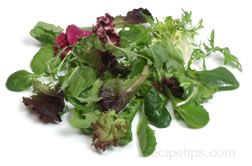 |
A mixture of small, young salad greens, herbs and edible flowers. The greens are a mixture of textures and sweet, spicy and bitter flavors. Among the greens commonly found in the mixture are arugula, dandelion, frisée, mizuma, mâche, radicchio, oak leaf, endive and sorrel. Mesclun is also known as mesculum, field greens, spring mix, spring salad mix, spring mix or field greens. |
Mustard Greens

Curly Mustard |
Cooking greens from the mustard plant that are grown in both red and green varieties. This green provides a peppery flavor to assorted cooked dishes or when eaten raw. The taste may be too pungent or bitter for some, but if blanched in salt water, it decreases the sharp bite. Mustard greens can be sautéed or steamed and added with other ingredients such as meat and vegetables to become a tasty side dish. Mustard greens are also known as curly or curled mustard, mustard spinach, Indian mustard of leaf mustard. |
|
Radicchio
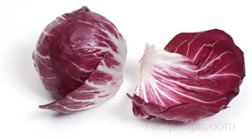
|
A vegetable from the chicory family, which has a tight head of dark scarlet leaves with creamy colored ribs. When it first begins to grow, radicchio has bright green leaves, which become deep green and then turn to burgundy red as they mature. The leaves are somewhat bitter tasting with a crisp texture and are used in salads and cooked dishes. The leaves may be rounded or elongated depending on the variety selected. In Italy, radicchio di Verona refers to the round leaf and radicchio di Treviso is the elongated leaf. It is also known as red chicory, red-leafed chicory, red headed chicory, or Italian chicory. |
| Radichetta (Asparagus Chicory) |
A salad green that grows with long thin stems with ragged or serrated green leaves. It is considered to be a green in the chicory family that is most often served for salads or as a cooked vegetable. It is also known as asparagus chicory. |
|
Spinach

Common Spinach
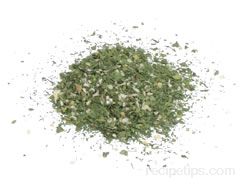
Dried Spinach Flakes
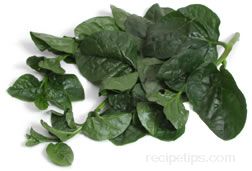
Asian Spinach |
A leafy green vegetable or salad green with a flavor that is slightly bitter, derived from the oxalic acid contained in spinach. There are basically two different varieties of spinach grown for consumption: the small, smooth, flat-textured leaf Spinach and the crinkle-textured broad leaf spinach. The flavor is the same for each variety, but the density or size of the leaves, the shape and texture of the leaves and the stalks all differ. Spinach is rich in potassium, iron, riboflavin, vitamin A, and vitamin C. When eaten raw, the nutrients are retained, however when cooked, spinach releases some of the nutrients into the liquid produced. By boiling the spinach green, the nutrients are released into the water. However, when sautéed or steamed, the juices can be used in the cooked spinach so the nutrients can be retained. Spinach is dried, chopped into bits, and mixed with other ingredients to be used as a food seasoning. There are four types of spinach often available that include the common spinach, New Zealand spinach, Chinese or Asian spinach, and water spinach. Common spinach has flat thin leaves, thin stalks and a medium green color. When eaten raw or cooked, the stalks are typically removed and the leaves are prepared for consumption. New Zealand spinach is a coarser, thicker leaf with a crinkled-texture. The leaf has an arrowhead shape with a fine fuzz covering the leaf, while the stalk is thicker than common spinach. The New Zealand spinach is best served as a cooked vegetable or ingredient to a food dish, providing a mellow grassy flavor. Chinese spinach is also referred to as Asian, bayam, Ceylon, malabar, tampala, or Vietnamese spinach, as well as alogvati, mong toi, saan choy, or yin tsoi. This type of spinach provides a crinkle-textured, thicker leaf growing on a denser stalk than common spinach. It is a variety that is commonly grown in Asia and India for both the stalks and the leaf. |
Turnip Greens
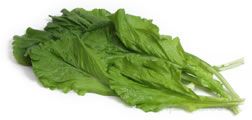 |
The leafy part of the turnip root that is served as a vegetable green. The greens are harvested when the turnip is young and tender, resulting in a tender, succulent green. Turnip greens can be sautéed or steamed and added with other ingredients such as meat and vegetables to become a tasty side dish. |
|
Watercress

|
A plant that is a member of the mustard family and is used as an herb and a salad green. Its leaves have a savory, spicy flavor that is suitable with many other foods. It originated in eastern Europe and western Asia and now grows throughout the world. It grows mainly in clear ponds, springs, and slow running creeks. In the United States, it is cultivated in the mid-Atlantic and southern states using special growing beds. It has a very long root system and clusters of dark green leaves that grow above the water. It is only harvested from clean water and is washed thoroughly after harvesting to remove any insect larvae that may be present. |
Greens Preparation
Greens do not require a lot of preparation. They basically require cleaning and drying before use or storage. Greens should be washed and dried thoroughly. If washing just before using in a recipe that requires steaming or boiling of the greens, it is not necessary to dry them. When dried, the leaves can be served whole, shredded or in small pieces.
If the greens need to be a smaller size before cooking or adding to a salad or other dishes, they can be torn into smaller pieces or they can be cut with a sharp knife. The knife should be stainless steel to prevent the greens from discoloring.
Cleaning Greens:
- Remove any damaged, wilted or yellowed leaves and cut off tough or stiff stems.
- Fill a large bowl with cold water and place greens in the water.
- Gently swish the greens around in the water and lift out. The dirt and sand will have settled to the bottom of the bowl.
- Empty the bowl and fill with clean water. Repeat the washing process. Repeat until no sediments remain on the bottom of the bowl when the greens are removed from the water.
- Larger leaf greens can be washed by holding under cold running water. Unfold any folded leaves to be sure to remove all the dirt.
- When clean, shake excess water from the greens.
Drying Greens:
It is important that the greens are dried properly after they are washed or if they are damp from moisture applied at the market. If the moisture is not removed, the wet greens will produce a soggy salad and affect the consistency of the dressing when it is added. If greens are stored when wet, the moisture will cause them to deteriorate faster.
- Place washed greens in a colander and allow water to drain off.
- Place several layers of paper towels down on a work surface and place the drained greens on the paper towels. Using more dry paper towels, pat the greens dry. Pat the greens carefully so that they do not become damaged.
- A salad spinner may also be used to dry the greens. When spinning greens dry, do not place too many greens in the spinner at one time. The greens will dry faster and it will prevent them from crushing each other.
- When the greens have been thoroughly dried, they are ready for use or they can be stored as shown above.
Head type greens, such as radicchio, can be washed under cold running water and the outer damaged or blemished leaves removed. Dry well with a paper towel before storing. If stored unwashed, remove any damaged or blemished outer leaves and be sure the head is dry before placing in a plastic bag and storing in the crisper of the refrigerator.
Greens Cooking
Quite often greens are eaten fresh. They are eaten on their own, mixed in with lettuce, mixed with several other varieties, or added to other salads. Although they are frequently eaten fresh, they can also be cooked using several different methods. Some of the common cooking methods used are shown below.
Blanching:
Blanching is used to soften the texture of some greens and to provide a flavor that is not as pungent as when raw. A recipe may call for some greens to be blanched before the main cooking method is used, such as sautéing. Softer greens should not need blanching.
- Bring water to a boil in a large pot.
- Add greens to the boiling water.
- Allow to cook for 5 to 10 minutes, just until the greens have wilted.
- Remove from the heat source and drain the water from the greens.
- Allow greens to cool before squeezing moisture from them. If they are not going to be used immediately, rinse them by running them under cold water and squeeze out excess moisture.
Braising:
Head-type greens may benefit from being blanched for 1 1/2 to 2 minutes before it is braised. Most leaf-type greens do not require blanching before braising.
- If working with a head-type green that has been blanched, cool under cold running water and then cut in half.
- Place the greens in a skillet and add broth until the greens are almost covered. Other flavorings can also be add along with the broth, such as onion, garlic or your favorite herbs.
- Cover the pan and cook at a simmer for 10 to 20 minutes until tender.
- Make a sauce to serve with the greens by boiling the cooking liquid left in the pan until most of the liquid evaporates.
Sautéing:
- For greens that have been blanched, place a small amount of oil in the pan. Nonstick pans will require less oil than other pans.
- Add greens to heated oil. Other flavorings, such as garlic and onion can be added and sautéed with the greens.
- Sauté for 3 to 10 minutes, stirring constantly.
- Remove from pan and serve while hot.
Steaming:
- Wash greens but do not dry. The water that remains on the greens will be enough to steam the greens.
- Place the greens in a heavy pan. Larger, firmer greens should have 1/4 to 1/2 inch of broth or water added to the bottom of the pan.
- Cover and simmer over low heat until greens are wilted. Cooking time may vary from two to 15 minutes depending on the size and toughness of the greens.
- Greens can also be placed in a vegetable steamer and steamed over boiling water.
Microwaving:
- Clean greens and do not dry.
- Place wet greens in a microwave safe dish and cover.
- Microwave for 2 minutes on high.
- Check for doneness and microwave for 1 to 2 additional minutes if necessary.
When cooking greens, be aware that they will reduce considerably when cooked. A pound of greens can be reduced down to 1 to 2 cups after they are cooked.
Tips
- Prepare greens a few hours a head of time to save the last minute rush. Wash and dry thoroughly and then lay them out flat between layers of clean, dry paper towels. Place in a plastic bag and refrigerate until ready to use.
- When washing greens, do not let them soak. Swish them in cold water several times and then dry.
- Use the liquid that is left from cooking greens to make sauces or to add extra flavor in soups.
- Blanching will lessen the bitter taste of some greens.
- To revive limp greens, add 2 to 3 tablespoons of lemon juice to ice cold water and let the greens soak in it, refrigerated, for approximately an hour.
- When adding dressing to a salad made up of greens, be sure to add a little at a time and toss thoroughly. Taste to determine if more dressing is needed. Avoid adding to much dressing, which will result in a soggy salad. Do not add dressing until just before serving.
- Be sure to purchase a large enough quantity of greens if you are going to cook them. Cooking them can reduce them to less then half their volume when done.
|
























